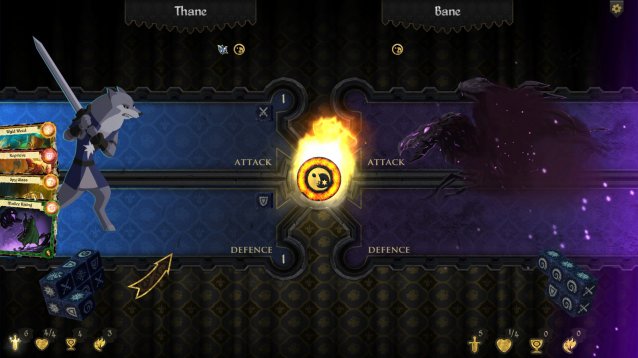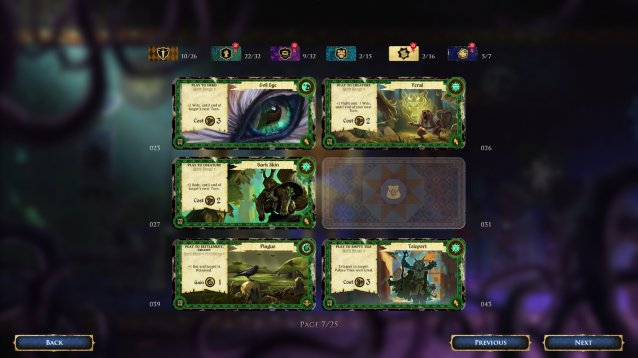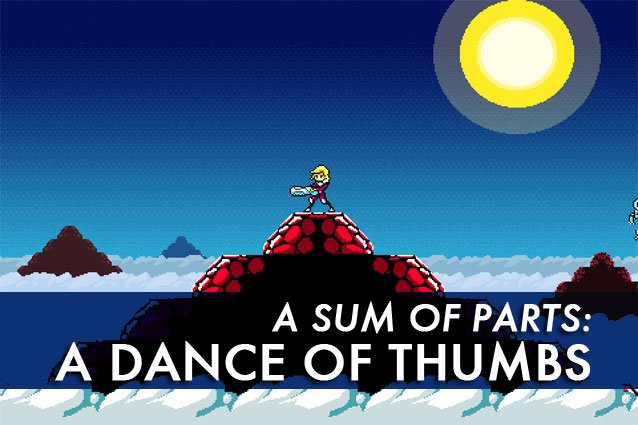


I love board games. Well, more honestly, I love the idea of board games. There’s a specific type that’s always fascinated me: the kind with tons of cards and different plastic figurines, where you set up a new dungeon or battlefield or space ship each time you play.
The problem is, finding a chance to play can be difficult, unless you have similarly-inclined friends nearby. Even when you do, dice and rulebooks can go missing, you might not have a big enough table, and you probably don’t get to play often enough to ever get a chance to truly master the game.
Armello is a kind of magical board game that not only solves these problems, but also leverages its digital platform so as to do things that are impossible for a physical board game. I don’t mean that it just keeps track of your die rolls and card decks – the very game mechanics themselves rely on a computerized back-end to really work. The game has some peripheral design issues, but the overall result is a lovely experience that feels part Settlers of Catan, part Redwall, and part Jumanji.

As one of four players (and you can play against any combination of humans and AI), you control an animal hero in the Kingdom of Armello. Dark days have come to the land, and the once-regal king has been afflicted with the curse that spreads through the realm: “The Rot,” an occult force that drives the game’s action. As the game’s days tick by, the king – a lion who reigns from the castle in the center of the hex-based game board – becomes increasingly infected with Rot, which eats away at his body with each dawn.
Inevitably, the king will die from his disease, and our heroes know this – in the few days you have before he is consumed by the Rot, you must vie with the other heroes to determine who will rule, and how. There are eight heroes, two from each clan: Bear, Wolf, Rabbit, and Rat, and each requires a different gameplay focus.
On paper, the game is complex. Each character has four stats: Fight, Body, Wits, and Spirit, which will govern things like how many dice you roll in combat or how many cards (beautiful, animated cards!) you’ll hold in your hand. The board is made up of hexagonal tiles: plains, swamps, dungeons, mountains, and towns, each of which have different properties. There’s equipment, spells, traps, and encounters, and outlining all the rules that underpin each of these elements is beyond the scope of this review.

There are four ways to win: You can storm the castle at the center of the board and battle the king himself. You can complete quests, take over towns, and defeat other players in battle to gain prestige, aiming to be the player with the most prestige when the king dies of his corruption. You can also gather four “Spirit Stones” which appear on healing altars at random times throughout the game, then enter the castle to purge the Rot. Or, you can embrace the Rot yourself, become even more corrupt than the king, and slay him.
While the first few games feel a bit disorienting, Armello reveals itself quickly to be a game about guessing which of these win conditions an opponent is trying to achieve and throwing as many obstacles as possible into their path. Thane, a wolf warrior, is probably the most straightforward character to play as at first: He’s a fighter, so you’ll want to look for ways to catch your opponents in open combat while searching for better combat equipment and stat buffs to his Fight and Wits. Sana, on the other hand, is a bear druid who is fragile in battle unless she’s fighting corrupted creatures and heroes – she’ll do best staying in the forests, boosting her Wits and Spirit, and collecting the right batch of spell cards. Then there’s Mercurio, a rat thief (talk about playing to stereotypes) who can send mercenaries into towns and set traps in forests. These require money, so anyone playing him will want to find ways to maximize their income. While any equipment, spell, or “trickery” card is available to any character, you’ll find that each hero type does best when using cards that play to their strengths.
The time it takes to explain how Armello works belies how simple it is to actually play, and that’s part of what makes it a magical board game. With the computerized game master handling all of the refereeing, your mind is free for more high-order considerations such as whether to boost your prestige and income by taking a nearby town, head toward your current quest, or work on waylaying a rival. All the complicated number crunching takes place safely under the hood, only coming to the surface when you’re required to throw dice (which the game lets you actually shake, and then lovingly renders tumbling around the screen). A full game of Armello can be played in well under an hour (longer in multiplayer, if you wind up with an opponent who forgets to hit the “end turn” button).

It’s a very lovely game, too. The animal heroes are designed like characters from a 1980s Don Bluth movie – I was reminded strongly of the intense sequences in The Secret of NIMH – and the environment evokes both a physical game board and an animated feature film. Each card features an animated, hand-drawn scene alongside the rules for its use, and each one is simply lovely.
Armello isn’t without its hiccups, though. In the games I played, it seemed like the easiest path to victory was by far prestige, with a Rot victory proving all but impossible. Once you’ve committed to a particular path, the inherent time constraint imposed by the king’s constantly-decreasing life means changing course mid-game can be disastrous.
There’s also the issue of randomness – the dreaded RNG. It plays a big role in the game, and it could definitely put a certain type of player off Armello completely. But it serves to keep Armello firmly rooted as a board game. That random element – die rolls, percent chances based on stats, and capricious spell effects – keeps the game from becoming too heavily weighted toward experts and inhospitable to newcomers. I think it’s too much to say that it’s a casual game, because careful planning and solid tactics are (usually) rewarded appropriately, but luck does figure heavily into the action and can frustrate even the best-laid plans.

This would be less of a problem if it was possible to play Armello on a tabletop with a few friends, but being that it’ll be a solitary experience for most of us for most of the time, I can certainly see how the whim of the dice could prove frustrating to many players and discourage long-term commitment to the game. Whether or not you’re that kind of player is going to be an individual call. Personally, I’ve enjoyed each subsequent game more than the last.
In any case, Armello is a remarkable achievement. Instead of simply transferring a board game experience to the TV or computer screen, developer League of Geeks has managed to escape the boundaries of the board game format using modern innovation. Arthur C. Clarke suggested that any sufficiently advanced technology is indistinguishable from magic, and in that light, Armello is quite definitely magical.
Armello was developed and published by League of Geeks and released September 1, 2015 for PC, Mac, Linux, and PlayStation 4 with an MSRP of $19.99. A copy of the game was provided by the publisher for this review.




 How to Repair Power Armor in Fallout 4: X-01 Power Armor Location
How to Repair Power Armor in Fallout 4: X-01 Power Armor Location Gold Guide For Fresh Meat Mission In GTA 5
Gold Guide For Fresh Meat Mission In GTA 5 A Sum of Parts: A Dance of Thumbs
A Sum of Parts: A Dance of Thumbs 10+ Gift Ideas for iPhone & iPad Owners
10+ Gift Ideas for iPhone & iPad Owners Depth Guide: Survive and Win as a Diver
Depth Guide: Survive and Win as a Diver